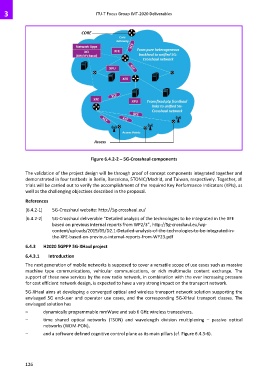Page 132 - ITU-T Focus Group IMT-2020 Deliverables
P. 132
3 ITU-T Focus Group IMT-2020 Deliverables
Figure 6.4.2-2 – 5G-Crosshaul components
The validation of the project design will be through proof of concept components integrated together and
demonstrated in four testbeds in Berlin, Barcelona, 5TONIC/Madrid, and Taiwan, respectively. Together, all
trials will be carried out to verify the accomplishment of the required Key Performance Indicators (KPIs), as
well as the challenging objectives described in the proposal.
References
[6.4.2-1] 5G-Crosshaul website: http://5g-crosshaul.eu/
[6.4.2-2] 5G-Crosshaul deliverable “Detailed analysis of the technologies to be integrated in the XFE
based on previous internal reports from WP2/3”, http://5g-crosshaul.eu/wp-
content/uploads/2015/05/D2.1-Detailed-analysis-of-the-technologies-to-be-integrated-in-
the-XFE-based-on-previous-internal-reports-from-WP23.pdf
6.4.3 H2020 5GPPP 5G-XHaul project
6.4.3.1 Introduction
The next generation of mobile networks is supposed to cover a versatile scope of use cases such as massive
machine type communications, vehicular communications, or rich multimedia content exchange. The
support of these new services by the new radio network, in combination with the ever increasing pressure
for cost efficient network design, is expected to have a very strong impact on the transport network.
5G-XHaul aims at developing a converged optical and wireless transport network solution supporting the
envisaged 5G end-user and operator use cases, and the corresponding 5G-XHaul transport classes. The
envisaged solution has
– dynamically programmable mmWave and sub 6 GHz wireless transceivers,
– time shared optical networks (TSON) and wavelength division multiplexing – passive optical
networks (WDM-PON),
– and a software defined cognitive control plane as its main pillars (cf. Figure 6.4.3-6).
126

